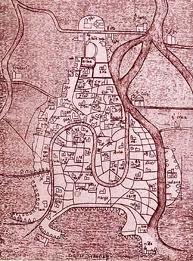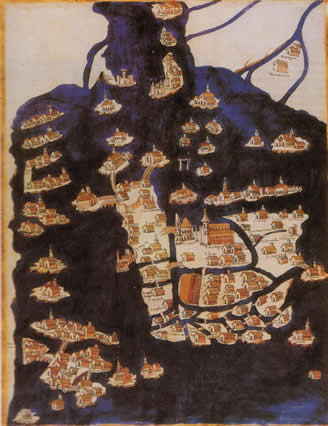In order to fully understand how the city of Venice first developed, one first needs to have a clear idea about the crucial role played by its location in shaping the city over the centuries. This location is the lagoon.
Regardless of what it might have been in previous times – farmland initially defended against the encroaching sea and then repeatedly submerged in the 4th and 5th Centuries, as some recent theories claim, or a vast zone continuously invaded by water, according to the traditional view – the fact remains that when the city of Venice started to take shape (in roughly the 7th Century ), the lagoon was an extensive area lying between the sea and the mainland where the rivers flowing down into the sea from the "Po" Valley met, turning into canals before finally reaching the sea through the apertures in the outermost sandbanks.
The lagoon is thus an environment that has a specific hierarchy thanks to the canals created by the ebbing and flowing tides. This hierarchy also determined the location of the earliest settlements, since Venice sits on either side of one of the most important canals (which would later become the Canal Grande ).
Venice should thus truly be considered a river city, though in this case the waters flow between fluid banks rather than between dry embankments. The city of Venice, however, has an unusual pattern, quite different from that of other mainland cities, where these generally develop outwards from a single nucleus.
Indeed, the original city of Venice developed in the exact opposite way, starting from a series of nuclei, built precariously on the first unstable islands as these started to emerge from the lagoon, separated by the canals and large expanses of water .
These small settlements cover a far smaller area than the waters between them and form what we now know as the city of Venice, at least longitudinally (this can be seen by the fact that two of the oldest churches – S.Nicolò dei Mendicoli, dating back to the 7th Century, and S.Pietro di Castello from the 11th Century – sit on the Eastern and the Western edges of the modern city).
Such an unusual environment was crucial for the fortunes of the city: the very reason that the city developed in such an awkward location, without any traces of previous settlements, it was not affected by the bitter fighting during the Early Middle Ages that led to neighbouring mainland cities being repeatedly razed to the ground.
Venice also grew thanks to man’s ability to overcome the harsh environment and his gradual awareness of how to enhance its advantages: easily defended, the ideal place for harbours, voluntary and conscious isolation from the two local powers (East and West) and full access to sea.
The city initially consisted of a few precarious villages on a series of islands, physically separated from each other, yet forming a concentration of settlements along this vast archipelago. The city was not alone: many monasteries and other minor settlements were built in the lagoon area (some of which still remain, such as Torcello and Burano; others having disappeared, such as Costanziaca and Ammiana). Like Venice, all were located at points where the main rivers/canals met between the mainland and the sea.
The original city was, therefore, a cluster of elementary urban units, each of which gradually gained the necessary spaces and infrastructure, such as the “campo” and churches where these early communities converged (proof of this is the density of Venetian churches and the lasting importance of the parish in city life as a factor of urban and social identity).
Unlike the Mediaeval mainland towns , whose physical centre is where the main roads meet adorned with squares and churches and hence the towns expand outward, Venice contains several centres that are relatively autonomous and have their own identity.
The city is based on these units and has grown over the centuries via a process of gradual “filling-in”, with the construction of new buildings, starting from the Rivoalto area and extending towards all the other settlements, thus reducing the width of the waterways between the islands and so forming the modern-day canals.
This process of “filling-in” took place over a relatively short period of time, meaning that the architecture is particularly homogeneous, the squares being the only obvious gaps. A similarity in style only stops where the city ends, at the water’s edge.
Venetian architecture is not, however, entirely identical: we can see tell-tell signs of the city’s increasing wealth - prestigious palaces and important funzioni - along the edges of the islands considered to form the real city centre, namely the Canal Grande, flowing inland from St. Mark’s Basin.
Despite this singular example of urban growth, Venice still provides plenty of instances of how specific construction techniques and technological solutions were constantly used to cope with the problems posed by the particular nature of the environment.
Not to mention the need to observe town planning rules right from the start that would otherwise not have been necessary. The relationship between the past and the present is, perhaps, stronger in Venice than in any other city in the world.
In other words, there are many eloquent testimonies still visible today of its history. Venice retains its original nature and yet is today totally different.
This paradox is easily explained: as already mentioned, the city was built over a relatively short period: founded at the end of the first millennium, it already had all its main structures (“
campi” and churches, canals and “
calli”, public buildings and homes, palaces and “
fonteghi”) by the 13th Century. Then there was no more growth, apart from some "
colmata",
filling-in the outskirts until expansion in more recent years.
Nevertheless, the city has managed to evolve over the centuries, as every building, church and palace shows signs of transformation over the centuries.
Franco Mancuso



